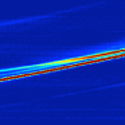Fragile state
In the presence of a magnetic field, the physics of a two-dimensional electron gas such as at very low temperatures is often determined by electron-electron interactions rather than single-electron effects alone. In the lowest Landau level, i.e., for states with the least cyclotron energy, the physics is particularly interesting near the case where the number of electrons exactly equals the number of available states (often referred to as a “filling factor ”). Here the ground state is expected to form a so-called quantum Hall ferromagnet, with fully polarized spins, even for the small Zeeman coupling typical in .
Writing in Physical Review Letters, Paulina Plochocka and co-workers at the CNRS in Grenoble, France, and colleagues in Israel and the US report detailed optical absorption measurements, which are often more reliable than transport measurements near integral filling factors, confirming that a full spin alignment does occur at in a quantum Hall ferromagnet. Though predicted by theory, the polarized state could not be concluded from earlier experiments. More significantly, the authors find that the spin polarization is very fragile and the spins depolarize rapidly as either the filling factor or the temperature changes even slightly. This depolarization appears to be consistent with the presence of spin textures, known as skyrmions, that have been predicted in quantum Hall ferromagnets. – Sami Mitra





